Remote work in numbers and diagrams

On My Circle, 35% of vacancies offering remote IT jobs are posted every month. At the same time, if we examine the database of the service summary, we will see that 67% of specialists are ready for remote work. There is an obvious gap between the demand of employers for remote work and the supply of applicants for it. As a result, there are 3-4 times more responses on vacancies with remote work than on vacancies with office work. In the face of a growing shortage of IT specialists, it is obvious that employers who are ready to go to distant work find themselves in a better position.
We decided to find out what the remote work market in Russia now represents. To do this, we conducted a survey among the users of “My Circle” and “Habrakhabr”, collected almost 3000 answers, processed them all, visualized and commented.
')
We hope our modest research will help employers to quickly understand how to work remotely in order to gain obvious competitive advantages in personnel. It can also be useful for job seekers who have not yet managed to work remotely to get an idea of the advantages and disadvantages of such work and, as a result, have a greater choice in the IT vacancies on the market.
How many are working remotely and where
At present, every third is working remotely. Remote spotters can be divided into three categories. Most remote workers are company employees, every fourth is a freelancer, every tenth is self-employed. Every fourth of distant workers works for a foreign company.

Only 20% of respondents do not have remote work experience. At the same time, the vast majority of them are considering the possibility of such work. That is, from the direction of applicants there are no obstacles to the transition to the remote.

The share of remote employees in relation to office ones is noticeably lower in Moscow and St. Petersburg, and noticeably higher in small cities. Also, their share is several times lower in large companies compared to medium and small ones. Most likely, this situation is connected not only with the established traditions of office work, but also with the fact that it is much more difficult to manage remote employees; with the growth of staff, the complexity of management increases exponentially.

The proportion of remote employees in relation to office slightly higher in age from 30 to 40 and significantly lower in the most adult ages. It is interesting why at earlier ages the share of remote workers is lower, although these people plunged into modern technologies at an earlier age than previous generations? Perhaps this is due to the fact that a person still still needs to undergo some initial socialization, to gain experience of full-time working interaction with others.
If you look at the areas of activity, the share of remote workers is higher among content managers, marketers and designers, and lower among Eychars, analysts, testers and administrators.

If you look at the salary, then the relative share of remote workers is noticeably higher in the cohorts with both the lowest and the highest wages. The first is explained by the fact that at a distance it is much easier to trust simpler and cheaper work. And the second is that many remote workers choose a job in a foreign company, whose salary is higher than in a domestic one. So, if, on average, a quarter of all remote workers work for foreign companies, then among those who have indicated large salaries are already up to three-quarters.

Three myths about remote work
Remote work is surrounded by a large number of myths. We have already touched on one of them a little higher and saw that not all remote workers work for foreign companies and earn more than others. Now let's look at a few more myths.
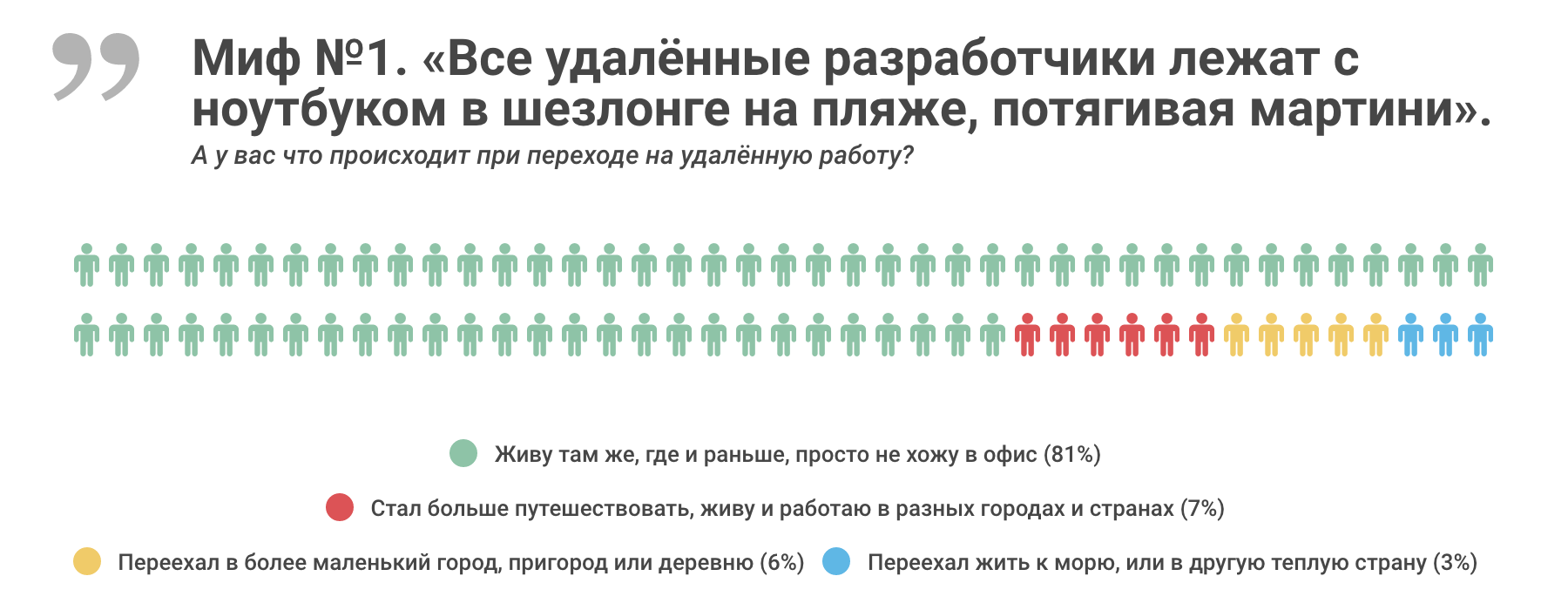
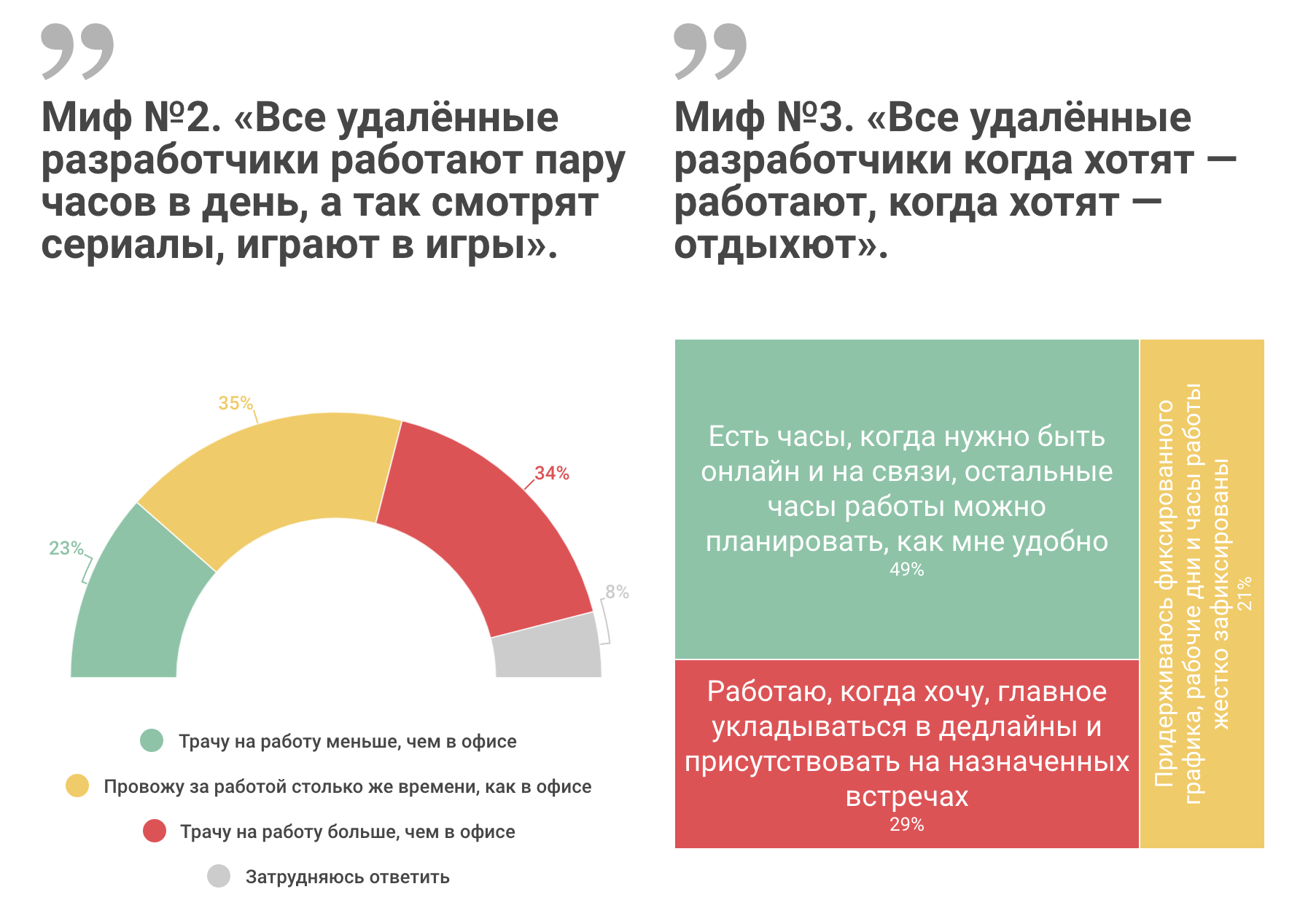
As you can see, only a small minority of remote users use the remote work format to move to where they are more comfortable to live, or to travel. Most people spend the same amount of time on their work or even more time than working in the office, but they manage their time more freely.
Advantages and disadvantages of remote work
The vast majority of remotes prefer to work from home. At the same time, almost every fifth works in a company that is located in his city.
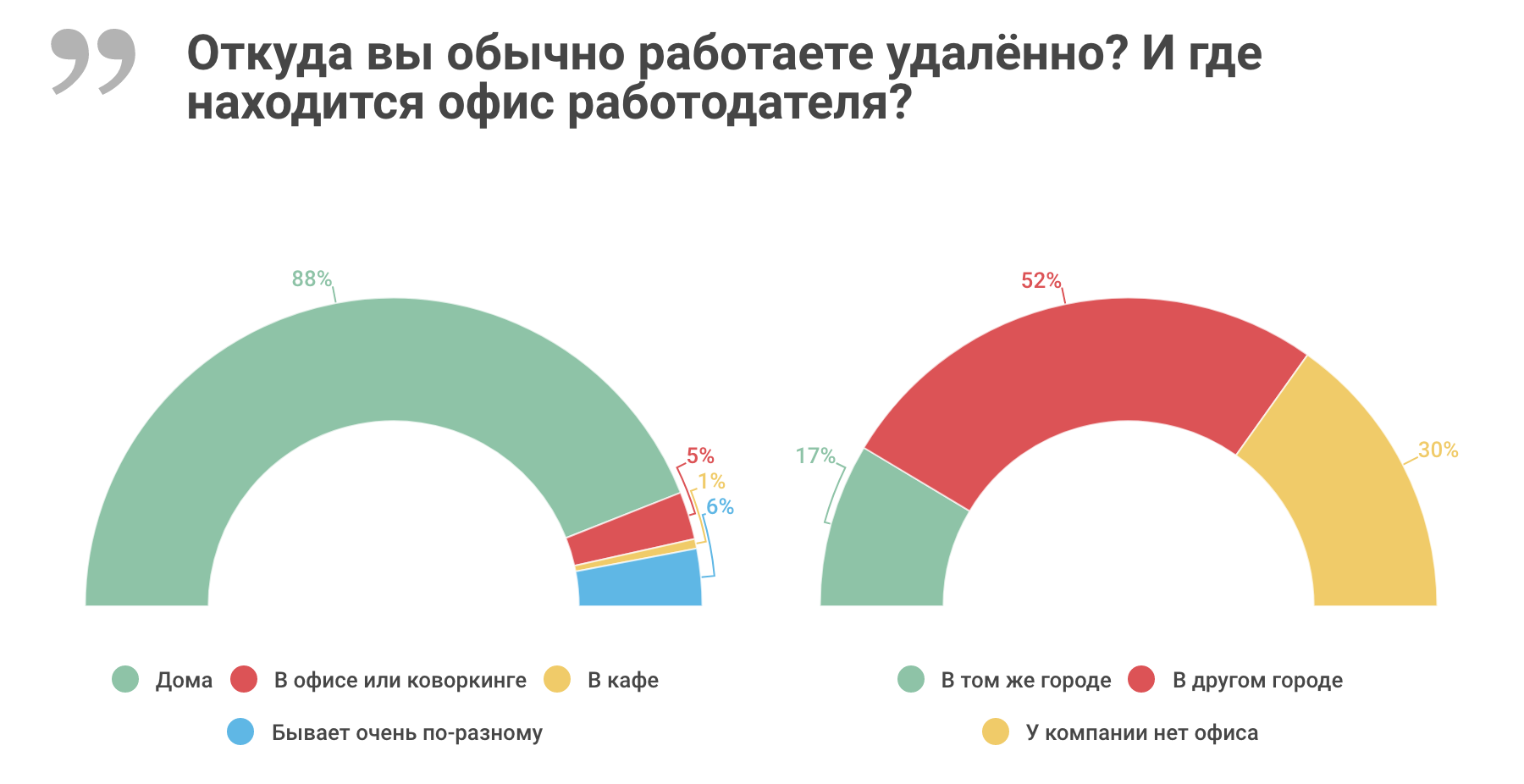
Remote workers communicate with colleagues remotely from office employees. Half of them communicate with colleagues several times a day. At the same time, the majority does not exist at all in the employer's office.

We asked the same question about the advantages and disadvantages of remote work for both those who already had experience of such work and those who have never had such experience, and obtained the following result. It is immediately obvious that people without experience tend to downplay the merits (the diagram on the left) and exaggerate the flaws (the diagram on the right), as it is common to people, there is nothing strange here.
Among the most frequently cited advantages of remote work are time savings on the road and flexible working hours. Many more like the potential to travel and work in comfortable, familiar environments.
Among the most frequently mentioned shortcomings is the lack of face-to-face communication with colleagues and many distracting household factors. Among the shortcomings, it is also most often indicated that there is a lack of informal communication with colleagues and a lack of understanding of the processes that take place in the company, a loss of involvement.

Most believe that job satisfaction and efficiency in it are in no way connected with the remoteness of this work. At the same time, it is three times more often said that satisfaction from remote work is higher than from office work, and twice as often - that efficiency is higher.

Remote work tools
Finally, we decided to find out with what tools people working remotely interact, it turned out to be a kind of top-list.
The grandfather of Skype (77% of respondents indicated it) and great-grandfather Email (64%) are still the favorite of remote corporate communication. On the second places such beginners as Slack (40%) and Telegram (38%). And anyway, the phone is still popular (38%).

There are no absolute leaders among the services for managing tasks. The first places belong to Jira (37% of respondents indicated this service for conducting tasks) and all the same Email (36%). The second places are occupied by Trello (24%) and Redmine (18%).
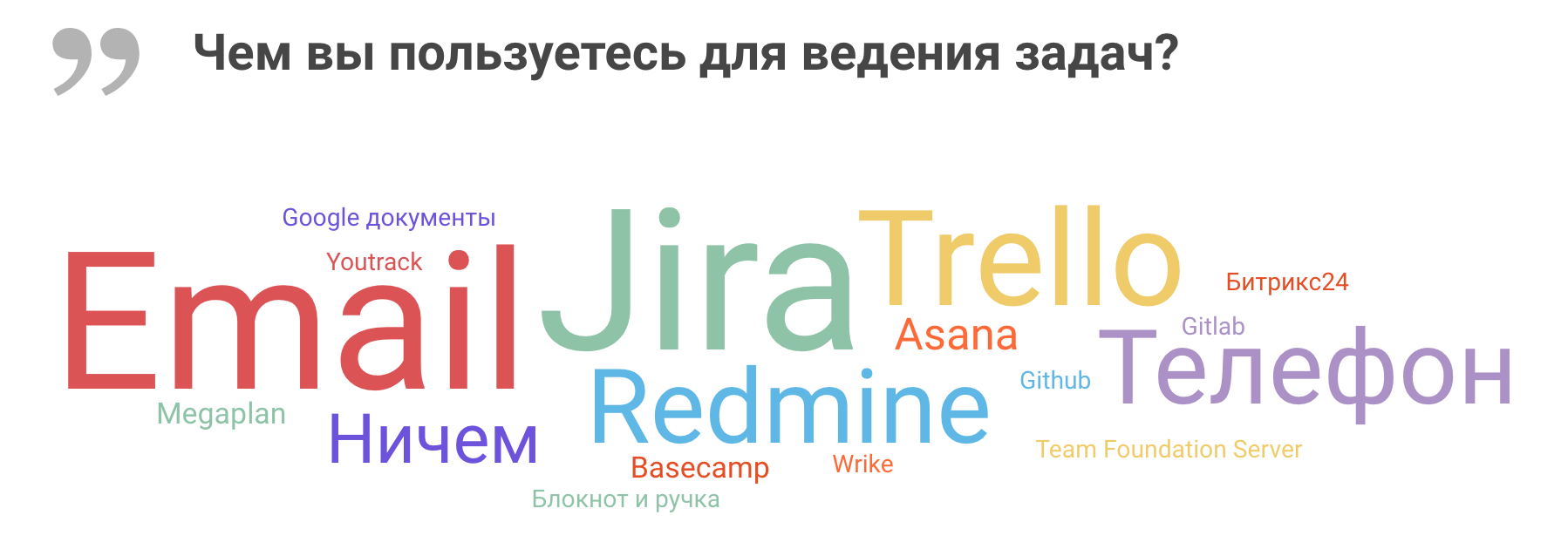
As it turns out, almost no one follows the time record with the help of special means: 56% said this. 21% use the Jira features and 11% use the Redmine.
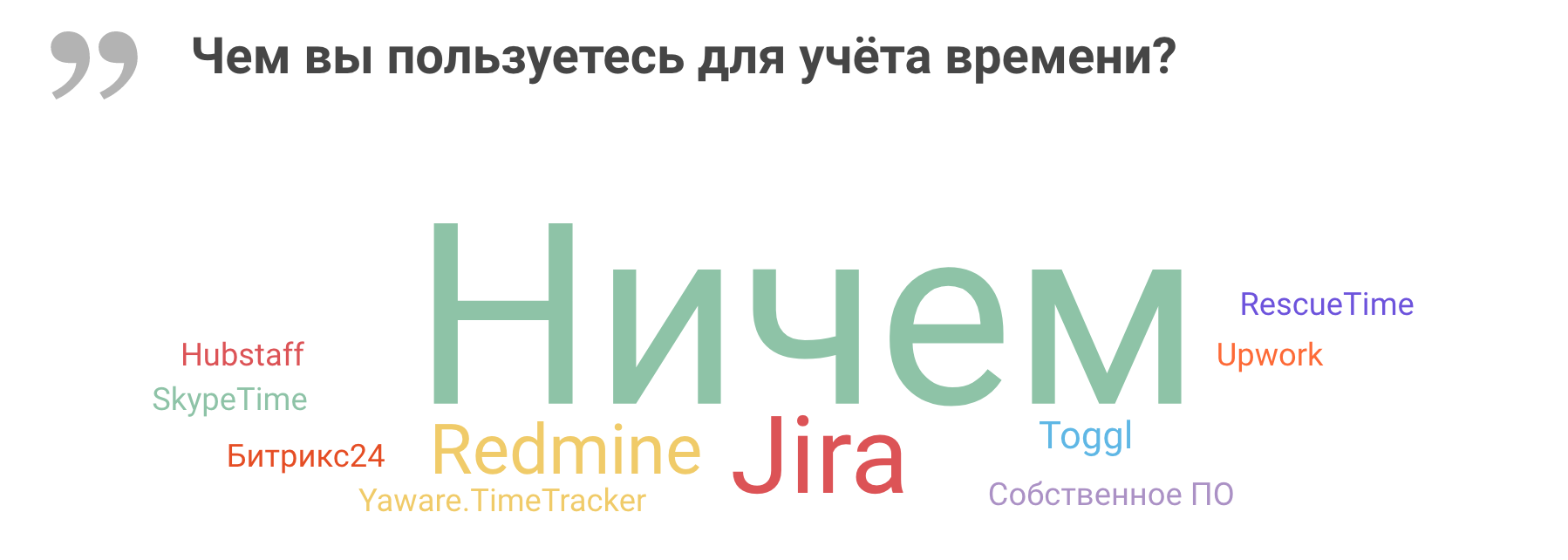
All charts are prepared using the service infogr.am
Source: https://habr.com/ru/post/330076/
All Articles